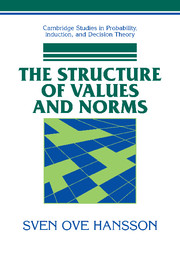Book contents
- Frontmatter
- Contents
- Preface
- PROLEGOMENA
- PART I VALUES
- 2 Exclusionary Preferences
- 3 Preference States
- 4 Changes in Exclusionary Preferences
- 5 Constructing Combinative Preferences
- 6 Pairwise Combinative Preferences
- 7 Decision-Guiding Combinative Preferences
- 8 Monadic Value Predicates
- PART II NORMS
- EPILOGUE
- Proofs
- References
- Index of Symbols
- General Index
7 - Decision-Guiding Combinative Preferences
Published online by Cambridge University Press: 13 August 2009
- Frontmatter
- Contents
- Preface
- PROLEGOMENA
- PART I VALUES
- 2 Exclusionary Preferences
- 3 Preference States
- 4 Changes in Exclusionary Preferences
- 5 Constructing Combinative Preferences
- 6 Pairwise Combinative Preferences
- 7 Decision-Guiding Combinative Preferences
- 8 Monadic Value Predicates
- PART II NORMS
- EPILOGUE
- Proofs
- References
- Index of Symbols
- General Index
Summary
Following the plan outlined in Section 5.3, we now turn to combinative decision-guiding (choice-guiding) preferences. As will soon be seen, there are several ways in which a preference relation can guide decisions or choices among the elements of the alternative set. Therefore, several types of such relations need to be developed.
In Section 7.1, a distinction is made between two major approaches to decision making: the prognostic approach, which tries to predict future decisions, and the agnostic approach, which treats future decisions as completely open and undetermined. In Section 7.2, a combinative preference relation for the prognostic approach is investigated. In Sections 7.3 and 7.4, a general framework for the agnostic approach is constructed. In Section 7.5, several preference relations that fit into this general framework are introduced, and in Section 7.6 their properties are investigated. In Section 7.7, finally, the various combinative preference relations studied in this and the previous chapter are compared in terms of their logical properties.
TWO APPROACHES TO DECISION MAKING
The need for combinative decision-guiding preferences was explained in Section 5.3. As agents with limited cognitive capacities, we often have use for comprehensive comparisons between groups of alternatives. To express such comparisons in formal language, a preference relation is needed that can guide choices between subsets (not only elements) of the alternative set. Given the definitions in Section 5.2, it does not make much difference if the relata of this relation are taken to be sentences or sets of alternatives.
- Type
- Chapter
- Information
- The Structure of Values and Norms , pp. 94 - 113Publisher: Cambridge University PressPrint publication year: 2001



